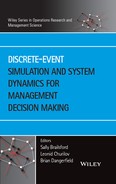0%
25Chapters
0-1Hours read
0kTotal Words
Book Description
In recent years, there has been a growing debate, particularly in the UK and Europe, over the merits of using discrete-event simulation (DES) and system dynamics (SD); there are now instances where both methodologies were employed on the same problem. This book details each method, comparing each in terms of both theory and their application to various problem situations. It also provides a seamless treatment of various topics--theory, philosophy, detailed mechanics, practical implementation--providing a systematic treatment of the methodologies of DES and SD, which previously have been treated separately.
Table of Contents
- Cover
- Wiley Series in Operations Research and Management Science
- Title Page
- Copyright
- Dedication
- Preface
- List of Contributors
- Chapter 1: Introduction
- Chapter 2: Discrete-Event Simulation: A Primer
- Chapter 3: Systems Thinking and System Dynamics: A Primer
- Chapter 4: Combining Problem Structuring Methods with Simulation: The Philosophical and Practical Challenges
- Chapter 5: Philosophical Positioning of Discrete-Event Simulation and System Dynamics as Management Science Tools for Process Systems: A Critical Realist Perspective
- Chapter 6: Theoretical Comparison of Discrete-Event Simulation and System Dynamics
- Chapter 7: Models as Interfaces
- Chapter 8: An Empirical Study Comparing Model Development in Discrete-Event Simulation and System Dynamics
- Chapter 9: Explaining Puzzling Dynamics: A Comparison of System Dynamics and Discrete-Event Simulation
- 9.1 Introduction
- 9.2 Existing Comparisons of SD and DES
- 9.3 Research Focus
- 9.4 Erratic Fisheries – Chance, Destiny and Limited Foresight
- 9.5 Structure and Behaviour in Fisheries: A Comparison of SD and DES Models
- 9.6 Summary of Findings
- 9.7 Limitations of the Study
- 9.8 SD or DES?
- Acknowledgements
- References
- Chapter 10: DES View on Simulation Modelling: SIMUL8
- Chapter 11: Vensim and the Development of System Dynamics
- Chapter 12: Multi-Method Modelling: AnyLogic
- Chapter 13: Multiscale Modelling for Public Health Management: A Practical Guide
- Chapter 14: Hybrid Modelling Case Studies
- Chapter 15: The Ways Forward: A Personal View of System Dynamics and Discrete-Event Simulation
- 15.1 Genesis
- 15.2 Computer Simulation in Management Science
- 15.3 The Effect of Developments in Computing
- 15.4 The Importance of Process
- 15.5 My Own Comparison of the Simulation Approaches
- 15.6 Linking System Dynamics and Discrete-Event Simulation
- 15.7 The Importance of Intended Model Use
- 15.8 The Future?
- References
- Index
- End User License Agreement
